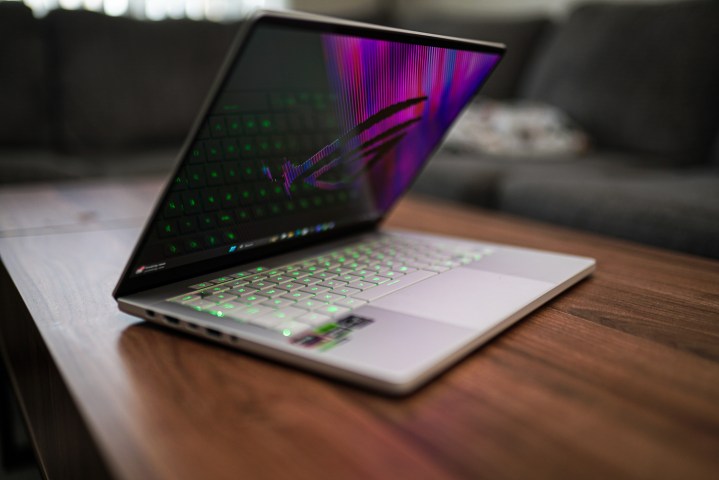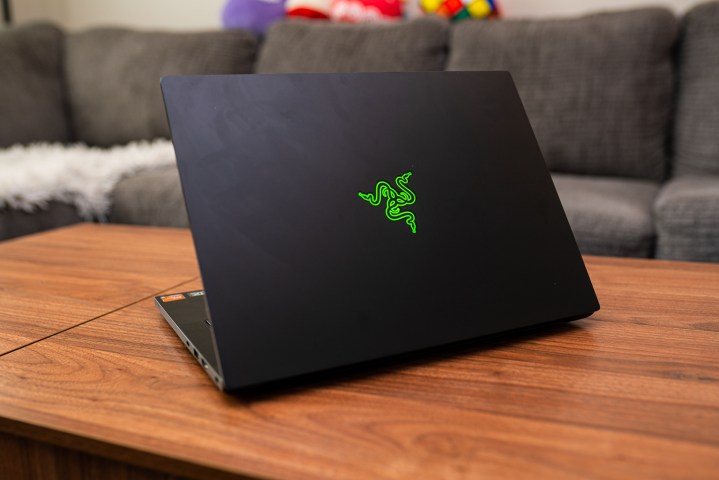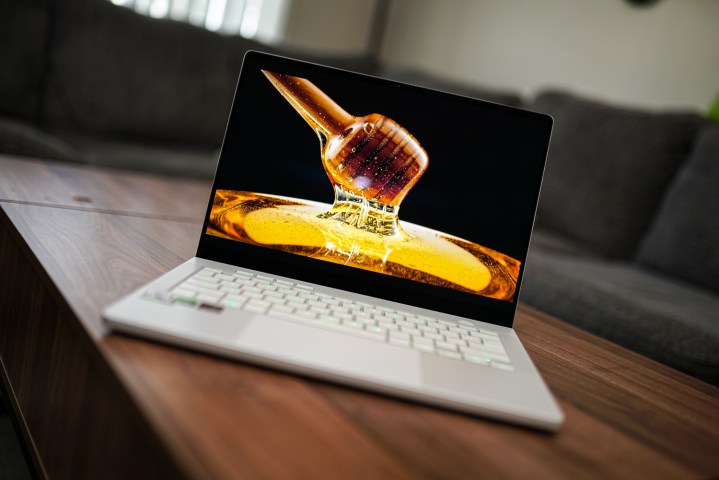
Over the last few years, 14-inch gaming laptops have only grown in popularity, and the two at the top of the pack are the Asus ROG Zephyrus G14 and Razer Blade 14. The two laptops are normally relegated to different classes, with Asus focusing on a reasonable price while Razer shoots ahead with all of the premium bells and whistles. That’s changing in 2024.
A radical redesign of the Zephyrus G14 puts it in direct competition of the Blade 14, with both laptops now offering a premium aluminum frame and some of the most powerful mobile hardware money can buy. Both are excellent laptops, but Asus has a particularly strong advantage this year.
Specs

At a high level, the Zephyrus G14 and Blade 14 have very similar specs. Both laptops are based around AMD’s eight-core Ryzen 9 8945HS and the lower-end of Nvidia’s RTX 40-series graphics cards. Both laptops top out at an RTX 4070. The Blade 14 goes down to an RTX 4060, while the Zephyrus G14 has configurations featuring the RTX 4060 and RTX 4050 as well.
Both laptops also come with 1TB of PCIe 4.0 NVMe storage and either 16GB or 32GB of DDR5 memory. The exact spec is a bit different, with Razer using DDR5-5600 memory and Asus using LPDDR5X-6400 — and both companies using a dual-channel configuration. The specs are very similar, but the devil’s in the details here.
Razer uses slotted memory on the 2024 Blade 14, allowing you upgrade the RAM down the line. Asus uses soldered memory, so you don’t have any options to upgrade or repair the laptop later on. That’s not a big deal if you go with a 32GB configuration, but the 16GB configuration of the Zephyrus G14 could present problems a few years down the line.

In addition, Asus doesn’t use the full wattage available to its GPU options. All three GPU configurations top out at 90 watts, while the GPU options in the Blade 14 can go up to 140W. If you know anything about Total Graphics Power (TGP) in laptops, that’s a sizable gap, and it translates into a performance difference.
Razer takes a back seat in other areas, however. Namely, the Blade 14 is thicker and heavier than the Zephyrus G14. Both laptops are thin, with the Blade coming in at 0.7 inches and the Zephyrus at 0.63 inches, but Asus takes a big lead in weight. The Zephyrus G14 is 3.3 pounds, while the Razer Blade 14 is 4.05 pounds. Asus has made a gaming laptop lighter than a MacBook Pro. In addition, Razer uses a 68.1 watt-hour battery while Asus uses a slightly larger 73 WHr battery.
Asus definitely sacrifices some hardware, but it’s able to achieve a slightly thinner and much lighter laptop in the process, all with a larger battery. Thankfully, there are some critical features that remain the same across the laptops, including an MUX switch and a USB-C port capable of 100 watts of power delivery.
Design

It’s tough to say which design is better between the Zephyrus G14 and Blade 14. Both look fantastic, with sleek aluminum frames and minimal branding. For my money, though, Asus has a slight edge with its stamped badge, slash lighting, and better color options.
The color options are interesting. Both Asus and Razer offer their laptops in either black or silver, but you need to spend more to get the silver option (called Mercury) with Razer. The Mercury finish is only available with an RTX 4070 (a $500 upcharge over the base model), while Asus offers both silver and black finishes for each configuration of the Zephyrus G14.

As for the outside of the laptop, the Zephyrus G14 features a stamped ROG badge, along with a diagonal line of LEDs, while Razer features a large Razer logo that can illuminate in green when the laptop is on. The Zephyrus definitely has a more unique design, and it manages to balance a creator-focused aesthetic with just a hint of gaming flair.
Ports

The Zephyrus G14 and Blade 14 come with a nearly identical port selection. Both laptops feature a full-size HDMI 2.1 output, two USB 3.2 Gen 2 Type-A ports, two USB-C ports, and a 3.5mm headphone jack. Razer, however, uses USB 4 for both of the USB-C ports, giving you 100W of power delivery with either. Only one of the USB-C ports on the Zephyrus G14 supports USB 4 and 100W of power delivery.
Asus has a feather in its cap with the inclusion of a micro SD card slot, but it’s really splitting hairs between the two.
Keyboard and trackpad

Both the Zephyrus G14 and Blade 14 come with a sizable trackpad and excellent keyboard, but there are a couple of key differences. The Blade 14’s keyboard has shorter travel, so it feels snappier to type on. The Zephyrus G14 has longer travel. If you have a heavy hand with typing, the Zephyrus G14 is slightly better, but both keyboards are comfortable.
There’s a larger difference between the trackpads. Both are big, but the Blade 14’s is bigger. It’s comically large, taking up around a third of the space below the keyboard. It makes using the laptop a bit more convenient, but the Zephyrus G14 isn’t far behind.
The only clear edge here is the inclusion of dedicated media buttons on the Zephyrus G14. The Blade 14 relies on function keys for things like volume adjustment, so the Zephyrus G14 is a bit easier to use on that front.
Performance
The Razer Blade 14 is faster than the Zephyrus G14, but that shouldn’t come as a surprise given the TGP gap. What’s shocking is how close the Zephyrus G14 is when it comes to gaming.

With 3DMark, we get a good baseline to compare performance, and it shows the Blade 14 in the lead by low single digits. The Blade 14 has a performance advantage, but it’s not as big as its TGP advantage would suggest. A lot of that has to do with the efficiency of RTX 40-series GPUs, which allows the Zephyrus G14 to offer most of the performance of the Blade 14 with a much lower power budget.

There’s a similar gap in real games. The Blade 14 is ahead, but in most games, it’s only by a few frames. The only exception is Cyberpunk 2077, where the Blade 14 shows a huge jump over the Zephyrus G14. The Zephyrus G14 gets most of the way there across games, but frame chasers are still better off with the Blade 14.

For overall performance, the Blade 14 once again is slightly ahead in PCMark 10 by about 5%. The larger design allows for more power to the GPU, and likely better cooling on the CPU, but both laptops stay relatively quiet under load.
Display

Across all previous categories, the Zephyrus G14 and Blade 14 have traded blows, but there’s a massive departure when we look at the displays. Starting with the Blade 14, it includes a 1600p IPS display with a 240Hz refresh rate. It’s one of the best IPS panels I’ve seen on a laptop, peaking at over 500 nits of brightness and with a color error of less than one.
It’s still no match for the OLED panel on the Zephyrus G14. Asus packs in an 1800p OLED display with a 120Hz refresh rate. This sounds like a big drop, but it’s important to remember the fast response times of OLED. The Blade 14 has a higher refresh rate, but the laptops feel surprisingly similar in terms of responsiveness.

The Zephyrus G14’s screen gets brighter — over 650 nits in HDR — but it’s really the contrast that matters. The Blade 14 managed a contrast ratio of just 1,200:1, which is typical of an IPS display. Meanwhile, the Zephyrus G14’s OLED panel has a theoretically infinite contrast ratio. When watching HDR movies and playing games, Asus is massively ahead thanks to the image quality OLED offers.
Razer offers an OLED panel on the Blade 15, so I’m not sure why the 14-inch model is stuck on an IPS panel still. Regardless, Asus has a dominating lead here.
Pricing
Another area where Asus shoots ahead is pricing, and that’s the biggest reason the Zephyrus G14 stands out so much. With the RTX 4060, 1TB of storage, and 16GB of memory, the Blade 14 comes in at $2,200. The Zephyrus G14 with the same configuration, including the OLED display, comes in at $1,600. That’s a $600 price jump for a heavier laptop that’s only slightly faster.
The price delta is even larger if you go for an RTX 4070 and 32GB of memory. The Zephyrus G14 is $2,000 with that configuration, while the Blade 14 is $2,700. The G14 has soldered memory, and it’s a touch slower, but it’s hard to justify a $700 premium on the Blade 14, and that’s before you even factor in the OLED display.
Which should you buy?

For the vast majority of people, the Zephyrus G14 is the clear winner in this matchup. It comes in with a similarly premium body, lighter weight, nicer screen, and much lower price, all while delivering similar performance. It doesn’t feel like you’re trading much away with the Zephyrus G14, and you’re getting an OLED display in the process.
That doesn’t mean the Blade 14 is automatically out of the running. It’s still a fantastic laptop, but it caters to a slightly different market. It tries to get as thin as possible without trading any performance, while the Zephyrus G14 makes more concessions on performance to achieve its form factor. The Blade 14 isn’t worth a $600 or $700 premium, depending on your configuration, but it’s still a great option if you can find one on sale.




